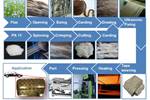DrapeCube offers cost-effective preforming process for FRP textile production
The DrapeCube offers a cost-effective design for the production of fiber preforms from textile semi-finished products.

Source | ITA of RWTH Aachen University
With the aim to provide cost-effective heating and forming of reinforced textiles for complex, 3D-shaped prototypes, as well as small production quantities, the Institute of Textile Technology at RWTH Aachen University (ITA, Aachen, Germany) is developing a forming station, termed the DrapeCube. Currently used by ITA for research purposes, the DrapeCube is said to avoid several high production costs associated with the preforming process, including the variance of component quality, increased component weight and other cost-intensive fluctuations associated with the manual manufacture of fiber-reinforced plastic (FRP) components. Further, compared to the solution of the stamp forming process used to shape textiles, the DrapeCube offers an alternative for smaller-scale production.
To heat the textiles, hot air is injected into the tool cavity from a pneumatic pressure pipe, and heated up to 200°C by an electric coil, thus applying heat to the textile in a controlled manner over a short period of time. According to ITA, this approach enables the thermoplastic adhesive material to be melted and cooled before, during or after shaping. Pneumatic cylinders are then used to generate the contact pressure. With a component projection area of 100 millimeters by 200 millimeters, contact pressure of up to 100 kPa can be achieved.
This post is courtesy of the CompositesWorld and AZL Aachen GmbH media partnership.
Related Content
-
ASCEND program update: Designing next-gen, high-rate auto and aerospace composites
GKN Aerospace, McLaren Automotive and U.K.-based partners share goals and progress aiming at high-rate, Industry 4.0-enabled, sustainable materials and processes.
-
Angeloni launches non-stitched multiaxial NCF fabric option
An adhesive grants the same stability of traditionally stitched composite fabrics, making Stratos suitable for use in a range of fibers and production processes.
-
Novel woven UD fabrics are designed for versatility, reliability
CAMX 2024: Zoltek introduces PX35UD0300EPW and PX35UD0600EPW, carbon fiber fabrics providing easy handling that have the potential to meet the evolving needs of composite applications.







.jpg;maxWidth=300;quality=90)




